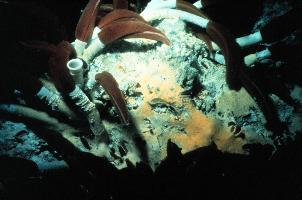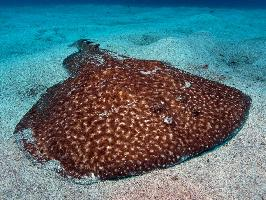
Súlyok és méretek
| Hossz | 2,4 m |
|---|
Veszélyeztetettség
| Veszélyeztetett |
Állatleírás
The Giant tube worm, scientifically known as Riftia pachyptila, is a remarkable species that thrives in one of the most extreme environments on Earth - the hydrothermal vents deep in the ocean. These vents are found at depths of over 5,000 feet (1,524 meters) where the pressure is intense, and sunlight is nonexistent. Despite these harsh conditions, the giant tube worm has adapted in extraordinary ways to not only survive but flourish.Measuring up to 8 feet (2.4 meters) in length, these worms are not your typical garden variety. They possess a unique, tubular body encased in a hard, chitinous tube, which serves as a protective casing against the crushing deep-sea pressure and predators. The tube worm's body is divided into several regions, but most notably, it lacks a mouth, stomach, and intestines. This absence of a digestive system is compensated by a symbiotic relationship with internal, chemosynthetic bacteria.
The vibrant red plume that protrudes from the top of their tube is perhaps the giant tube worm's most distinctive feature. This plume is used for gas exchange; it absorbs hydrogen sulfide emanating from the hydrothermal vents, along with oxygen and carbon dioxide from the water. The hydrogen sulfide, toxic to most forms of life, is a source of energy for the bacteria living inside the tube worm. These bacteria are capable of chemosynthesis, a process where chemical energy is used to produce carbohydrates from carbon dioxide, essentially feeding the worm by converting inorganic molecules into organic nutrients.
Living in colonies, giant tube worms are anchored to the seafloor by their tubes, which are made from a substance secreted by a gland in their body. The environment around hydrothermal vents is dynamic and can change rapidly. Vents can cease activity, and new vents can form, which means the worms need to be resilient and adaptable. Despite the seemingly inhospitable conditions, the area around the vents teems with life, forming a unique ecosystem with the giant tube worm at its center.
The discovery of Riftia pachyptila in the late 1970s challenged our understanding of life on Earth. Until then, it was believed that sunlight was a necessary component for life. The existence of these worms and their reliance on chemosynthesis illuminated the possibility of life in environments previously deemed uninhabitable. It has even prompted scientists to speculate about life on other planets and moons where similar conditions might exist.
The reproductive strategies of giant tube worms are another area of fascination. They reproduce sexually, releasing eggs and sperm into the water, where fertilization occurs. The larvae are planktonic, drifting in the ocean currents until they find a suitable hydrothermal vent to settle on and grow.
In conclusion, the giant tube worm, Riftia pachyptila, is a testament to life's adaptability. Thriving in the extreme environment of hydrothermal vents, these worms have developed unique physiological and symbiotic adaptations that allow them to exploit a niche where few other organisms can survive. Their existence challenges our perceptions of life's boundaries and continues to inspire scientific inquiry into the mysteries of the deep ocean.
Hasonló állatok
Új állatfotók
Top 10 állat
- Dolphin gull (Leucophaeus scoresbii)
- Japanese macaque (Macaca fuscata)
- Stone loach (Barbatula barbatula)
- Russian tortoise (Testudo horsfieldii)
- Galápagos tortoise (Geochelone nigra complex)
- Greek tortoise (Testudo graeca)
- Diana monkey (Cercopithecus diana)
- Common flying dragon (Draco volans)
- Moustached guenon (Cercopithecus cephus)
- Galápagos penguin (Spheniscus mendiculus)


